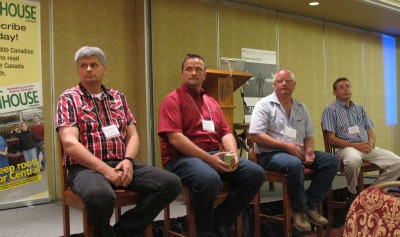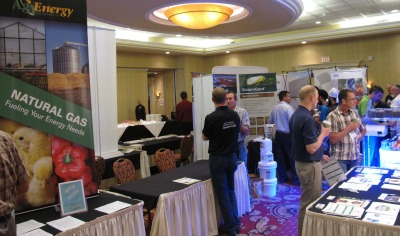
June 21, 2013, St. Catharines, Ont. — Water, pest, downy mildew and
environmental control management were the key themes tackled at this
year’s Greenhouse Canada Grower Day (June 19).
June 21, 2013, St. Catharines, Ont. — Water, pest, downy mildew and environmental control management were the key themes tackled at this year’s Greenhouse Canada Grower Day (June 19).
Attracting one of the largest audiences in many years, and great Q and A interaction between speakers and attendees, the event also featured a 30-booth trade show.
Four of the sessions focused on water management issues.
GROWERS TALK ABOUT WATER MANAGEMENT
Collecting rainwater and recycling irrigation water are among strategies employed by Rosa Flora Inc., a leading cut flower grower with facilities in Dunnville, Ont., and Havesome Produce, a longtime pepper growing operation located near Simcoe, Ont.

|
| Water management panelists included, left to right, Eric Haverkamp, Ralph DeBoer, Lloyd Rozema and Wayne Brown. |
Southern Ontario receives about a metre of rain each year, a key resource to access. “We try to capture as much rainfall as well can,” said Ralph DeBoer, operations manager of Rosa Flora.
With 14 hectares of production – the main crops are gerbera, alstroemeria, stephanotis, snapdragons and Sweetheart roses – the company can’t afford to waste any water. They require about 14.6 million litres of water per hectare each year.
All drain water is recycled, and the fertilizer recaptured.
Rosa Flora also utilizes innovative wetland filtration systems with great success, in addition to a UV sterilizer and cloth-filtering unit.
The wetland filtration systems work well, but the groundcover plant material – primarily bull rushes – takes some time to establish. But once in place, little maintenance is required.
Havesome Produce is a family-run, two-acre greenhouse operation near Simcoe. It was one of the first greenhouses in the province to specialize in peppers.

|
| About 175 people attended this year’s Grower Day. |
“A good water supply, both in terms of volume and quality, is essential for greenhouse vegetable production,” Eric Haverkamp explained.
They utilize a two-pond water collection system, augmented by well water. Included is a collection pond and a supply pond, both 16 feet deep and separated by an eight-foot dam with tile to permit water flow between the two ponds.
Benefits of the system include cool water (due to the depth of the ponds) that is helpful during summer irrigation, a clean source, a natural pH buffer, and a simple design. It requires very little regular maintenance, said Haverkamp.
The water is tested every couple of weeks, and the ponds are aerated to control algae growth.
CONSTRUCTED WETLANDS SPECIALIST
Lloyd Rozema, president of Aqua Treatment Technologies, helped install the wetlands filtration systems at Rosa Flora.
He has been involved in the design and construction of about 100 constructed wetlands projects across North America. These systems are treating about 2.5 million litres of wastewater each day.

|
| The trade show featured 30 suppliers, and was quite busy during each break. |
His Aqua Wetland System consists of two or more cells in series. Each cell is lined with PVC liner, filled with root-bed media, and covered with bull rush plants.
Wastewater, including greenhouse leachate, is pumped through the cells to be treated biologically. The water “percolates down through the system,” said Rozema.
The result is a highly effective treatment process that requires very little ongoing maintenance.
The system is quite versatile, and can be designed for small domestic sewage projects of just under 2,000 litres per day, or large greenhouse leachate projects handling about one million litres per day.
IMPATIENS DOWNY MILDEW UPDATE
Wayne Brown, greenhouse floriculture specialist with the Ontario Ministry of Agriculture, Food and Rural Affairs, provided an update on impatiens downy mildew.
Impatiens has been one of the biggest success stories of the past 25 years or so, he said. Great breeding has resulted in ideal greenhouse and landscape performance. Consumers love them.
Downy mildew, however, has become a major challenge of late. “This great success story has gone awry in less than five years.”
Early symptoms on upper leaf surfaces include a light green, yellowing or stippling of leaves; downward curling of infected leaves; and a possible grey/green mottling on upper leaf surfaces.
On lower leaf surfaces, visual clues can include velvety white growth and a heavy mass or sporulation.
In more advanced stages, leaf yellowing is common, as is leaf drop.
Downy mildews belong to the oomycetes group of fungi (water moulds), and are crop specific. They are closely related to pythium and phytopthora.
The spores spread in air and water. There are two main routes of entry into a greenhouse, including infected plant material (cuttings, rooted plugs or liners), and wind dispersal – the spores can travel considerable distances.
Preventive measures begin with effective sanitation, and growers should separate vegetatively propagated material from seed propagated material.
“Monitor cuttings closely from the moment they arrive,” said Brown. “Irrigate early in the day and avoid long periods of leaf wetness.”
Other steps include maintaining proper temperature and RH control, along with good air movement. Growers should also establish an effective fungicide rotation to prevention infection.
“If disease is detected,” said Brown, “remove the affected plants in closed containers and send them to the landfill.”
Not all varieties are affected, and growers should check with their suppliers.
Breeders are tackling the problem and breeding for resistance.
There are alternatives growers can consider, including begonias, browallia, New Guinea impatiens, nemesia, lobelia and fuchsia.
For growers, control may be possible. However, there are no effective control strategies once plants are in the landscape. The pathogens can survive in the soil and in plant residue for a long time.
OPTIMIZING ENVIRONMENTAL CONTROL
Albert Grimm, head grower at Jeffery’s Greenhouses in St. Catharines, outlined some of the ways environmental computers improve crop quality and production.
“With climate control, we have choices,” he said. “We can create conditions for optimal growth and plant development, or we can create conditions for specific responses from our crops.”
For example, do you want to:
• Optimize biomass production?
• Balance fruit and biomass production?
• Reduce the size of the canopy versus flowers?
• Increase or decrease stem length?
All are possible by environmental control measures.
By increasing the Average Daily Temperature, growers can increase the rate of node formation, have plants make leaves more quickly, promote faster maturity and flowering, and have a modest increase in internode length.
By decreasing ADT, growers can decrease the rate of node formation and slow down the maturity and flowering rates.
A “one size fits all” climate setting doesn’t exist, said Grimm. Growers should adjust the greenhouse climate according to response rates of different crops, the crop stage, the available light energy, and the status of the crop versus the objective (“are we on time” and “are plants the right size”).
Climate control computers can save big on energy costs. Growers can use them to dynamically adjust temperatures based on available light and /or light-sum; to adjust heat/vent targets to store and release solar power in the greenhouse; and to more accurately control relative humidity and vapour pressure deficit.
SUCCESS WITH BIOPESTICIDES
Biocontrols are an effective part of IPM programs, with new products continually being introduced.
Dr. Anissa Poleatewich, a plant pathologist at the Vineland Research and Innovation Centre, says they can be used as a preventive measure, or as an effective tool to deal with problems as they arise.
Biofungicides are useful micro-organisms, such as specialized fungi and bacteria, that attack and control plant pathogens and the diseases they can pass along to plants. They manipulate the microbial environment and make is less inhabitable for pathogens.
Poleatewich listed several benefits of using biopesticides, including:
• Resistance management – alternative modes of action.
• Short re-entry and pre-harvest intervals.
• Most are exempt from Maximum Residue Limits.
• Worker safety.
• Consumer demand/perception.
• Help maintain populations of beneficial insects.
• Align with market trends toward sustainability.
Biopesticides act preventively; are effective at low to moderate pressure; may be used in organic production; promote growth; help plants resist stress; and enhance the availability of nutrients.
However, they don’t offer 100 per cent protection, can’t cure diseases (with a few exceptions), and don’t work well within environmental extremes.
“Most biological controls are preventive,” said Poleatewich. “They must be applied before symptoms appear.”
She said it’s a myth that biopesticides are intended to replace traditional chemicals. “Most biopesticides are intended for use in conjunction with traditional chemicals.”
Poleatewich said growers should only use registered biopesticides, consult with specialists or researchers, apply according to label instructions, and check for compatibility and synergies with other products.
FUTURE FAVOURITES?
In addition to his duties as Grower Day moderator, Melhem Sawaya (Focus Greenhouse Management) was the final presenter. He highlighted some of the varieties that caught his attention while touring this year’s California Spring Trials.
His July and August features in Greenhouse Canada cover many of these same varieties; check the print editions, or read them online in our digital editions or features archives.
Print this page